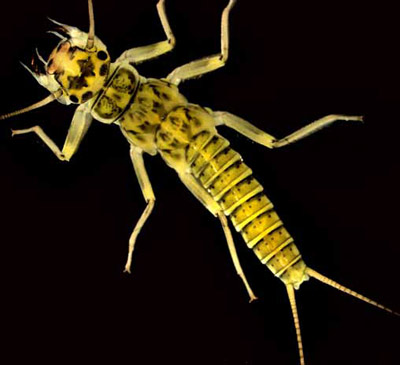Aquatic and riparian habitats make up less than 2% of the landmass, but are home to a disproportionately large number of species, making these habitats among the most productive ecosystems in the region (Asplund & Gooch 1988, Briggs 1996).

© David Buchwalter / NABS
Aquatic and riparian habitats are also among the most endangered ecosystems, facing threats from pollution, development, logging, grazing, and climate change, among others. In order to protect, maintain, and restore aquatic and riparian ecosystems, it is important that we measure and evaluate the condition of the organisms living there. One group of organisms that helps scientists to monitor the health of freshwater ecosystems is aquatic macroinvertebrates.
Aquatic macroinvertebrates are small organisms that have no internal skeletal system and live part or all of their lives in water. They are ubiquitous in freshwater ecosystems around the world and are found in both lotic systems—systems of flowing water, such as streams, rivers and springs, as well as in lentic systems—systems with standing or still waters, such as lakes, ponds and tinajas (depressions in rock that capture and hold water from rain or floods). They comprise a rich and diverse group of organisms that includes insect larvae, worms, snails, crayfish, and other crustaceans, such as clam shrimp, fairy shrimp, and water fleas. They also include many invertebrate species that are typically associated with terrestrial habitats, but spend some portion of their life as aquatic organisms (for example butterflies and moths in the family Pyralidae).
Aquatic macroinvertebrates are ecologically significant because they have the ability to integrate changes in both the aquatic and associated terrestrial environment. This sensitivity to environmental change helps scientists who study aquatic macroinvertebrates to detect physical, chemical, and biological changes in the ecosystems where they live.
Distribution
Aquatic macroinvertebrates can be found throughout the southwestern United States, from the high elevation coldwater montane streams in northern New Mexico and southern Colorado, to the warm water bodies at lower elevations in southern Arizona, New Mexico, and Texas. Many species occur in most or all of these habitats, while others have very limited distributions. For example, the Quitobaquito spring snail (Tryonia quitobaquitae), a very small aquatic snail (roughly the size of a gnat) only occurs in Quitobaquito Springs in Organ Pipe Cactus National Monument. Similarly, the Montezuma Well springsnail only occurs at Montezuma Well, a unique limestone sink pool within Montezuma Castle National Monument. Finally, the playa lakes in the Chihuahuan Desert parks contain specialized freshwater assemblages of invertebrates, such as clam shrimp and fairy shrimp, which provide important food for migrating waterfowl.
Prepared by Stacy Stumpf, Patty Valentine-Darby, and Evan Gwilliam, NPS Inventory and Monitoring Program, 2009.
Part of a series of articles titled Aquatic Macroinvertebrates in the American Southwest.
Last updated: May 6, 2015
